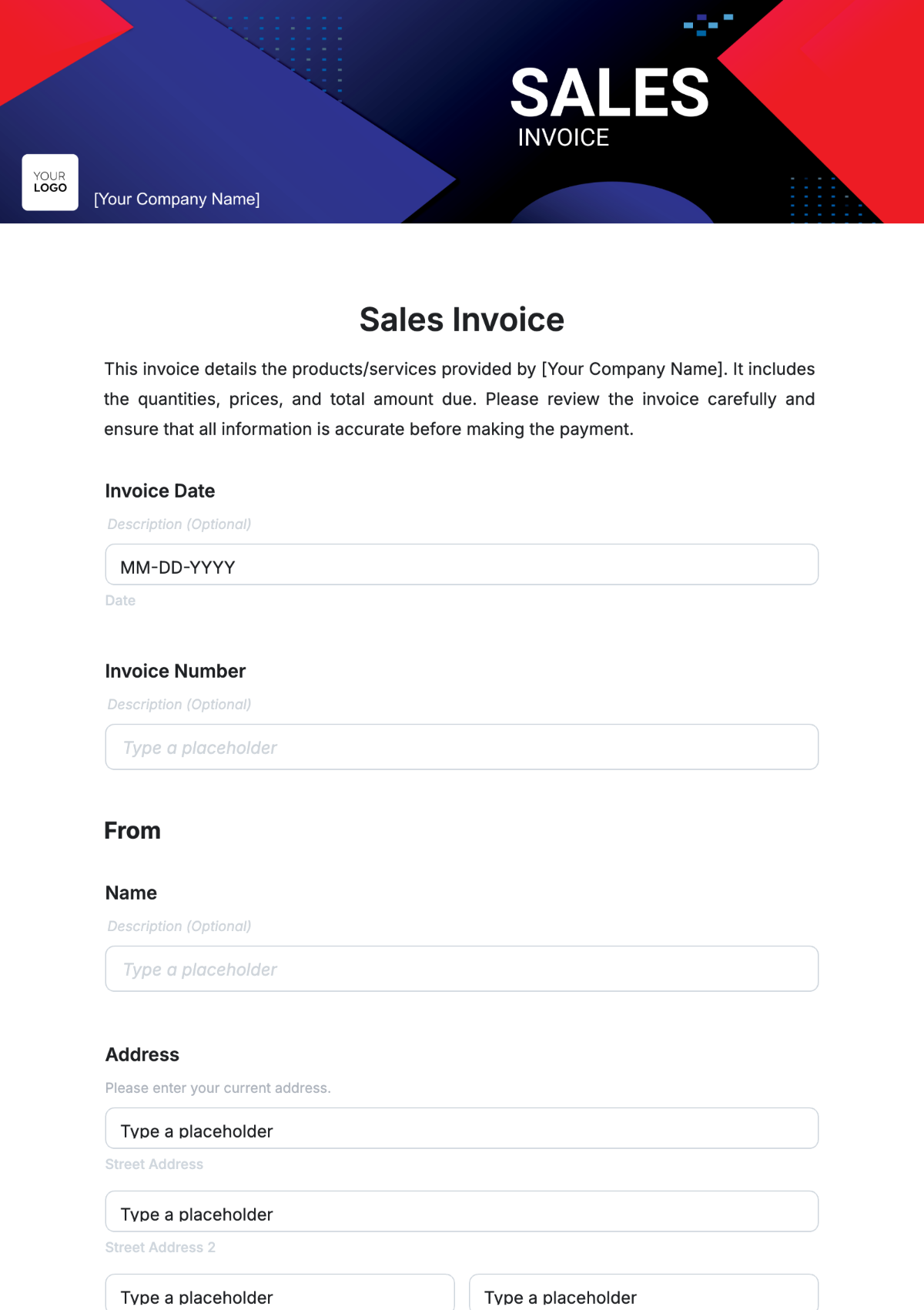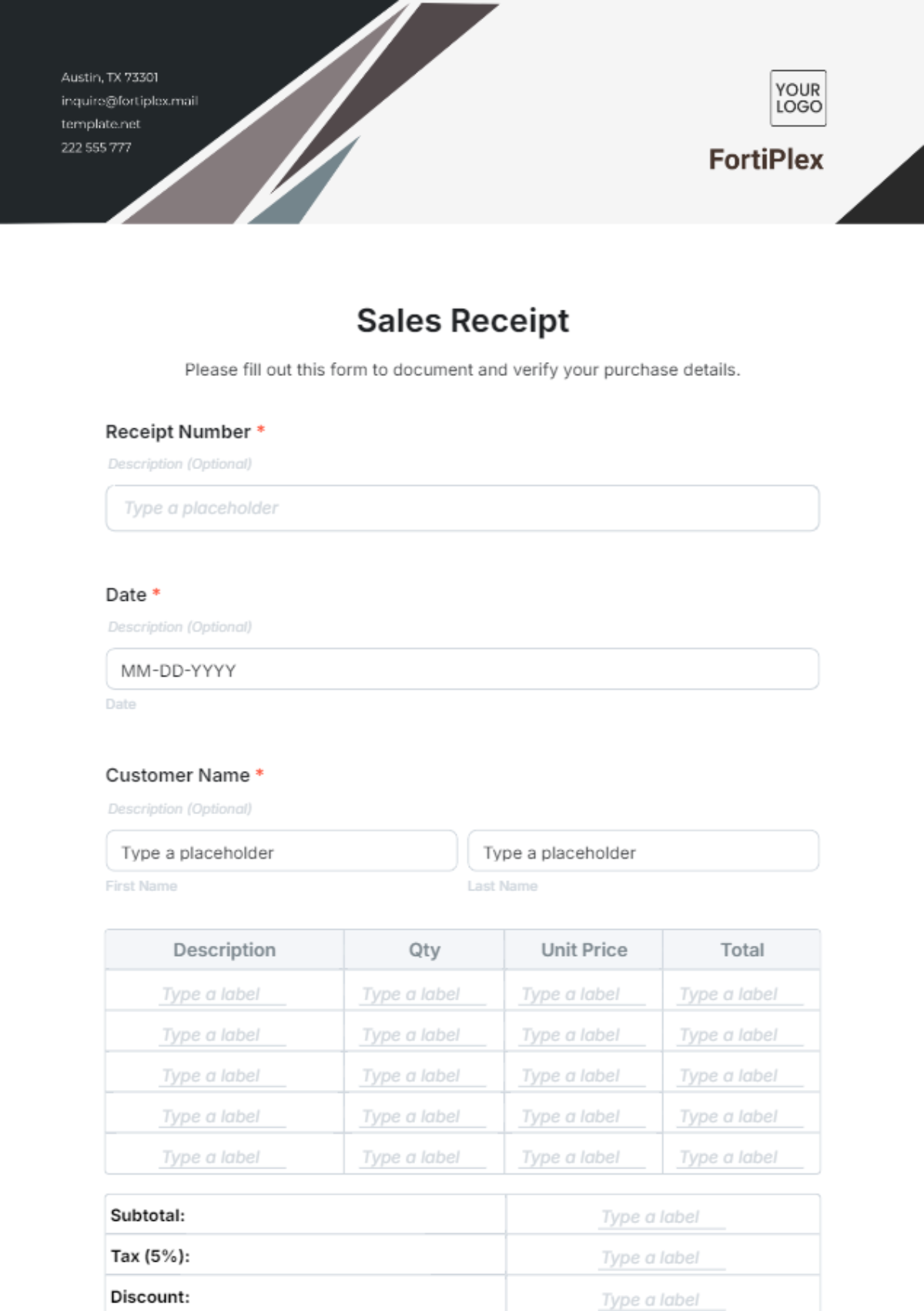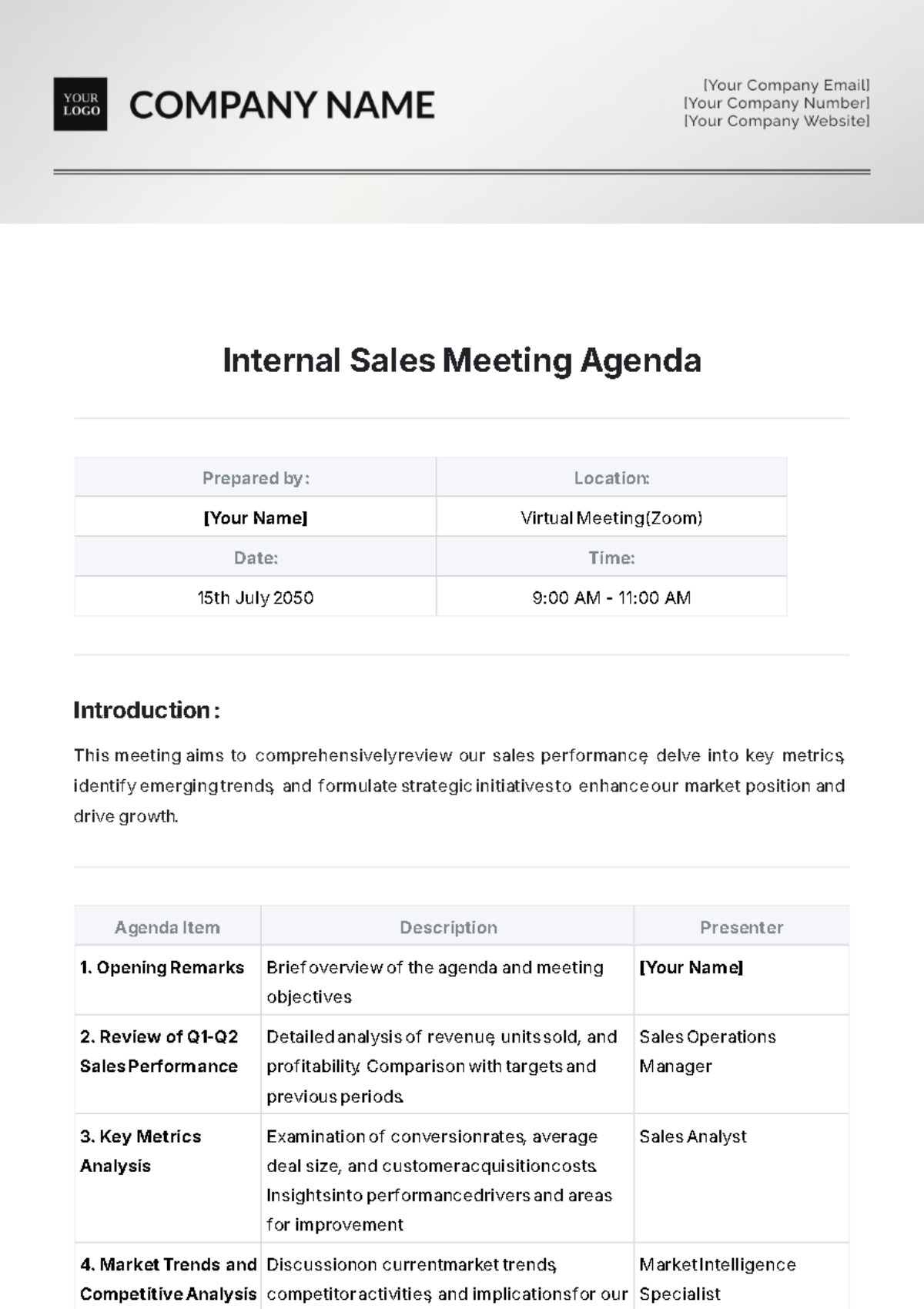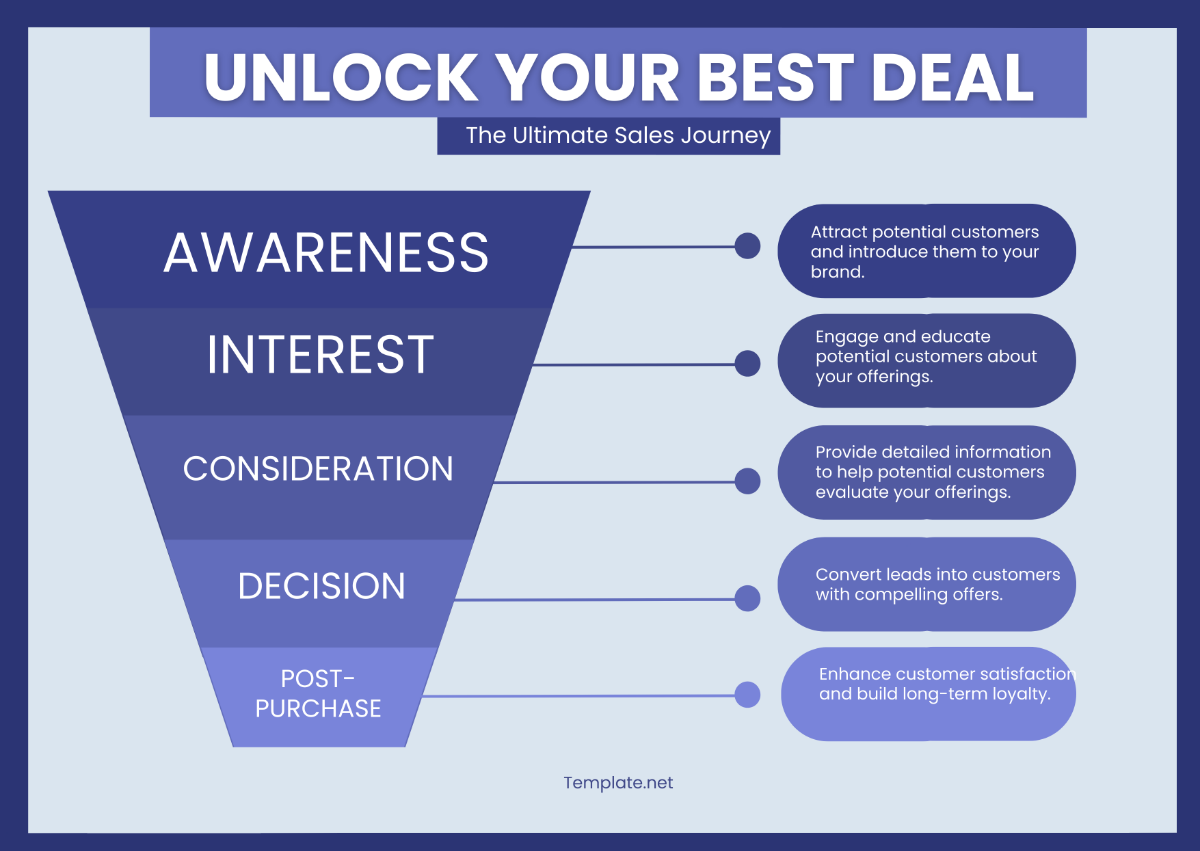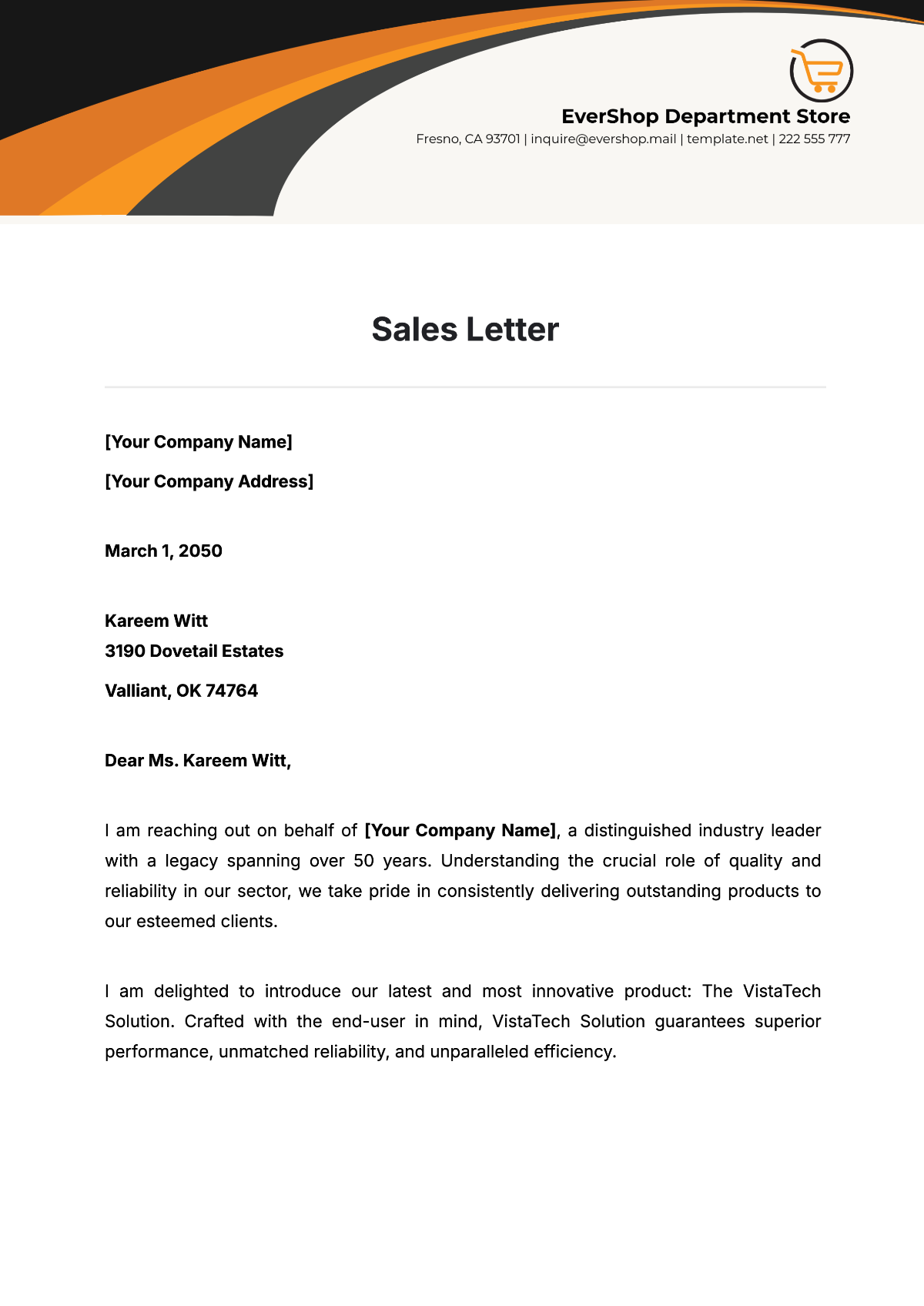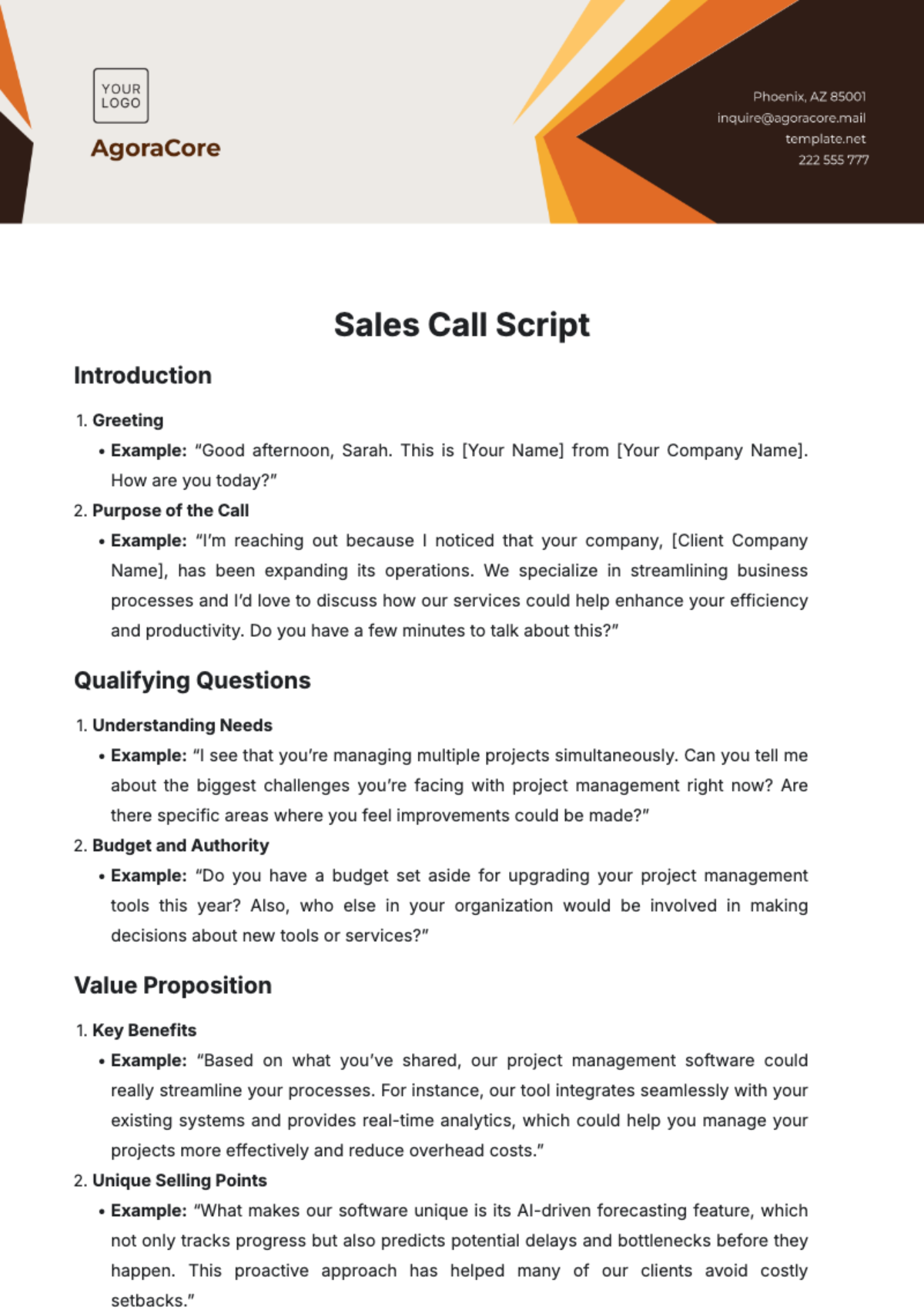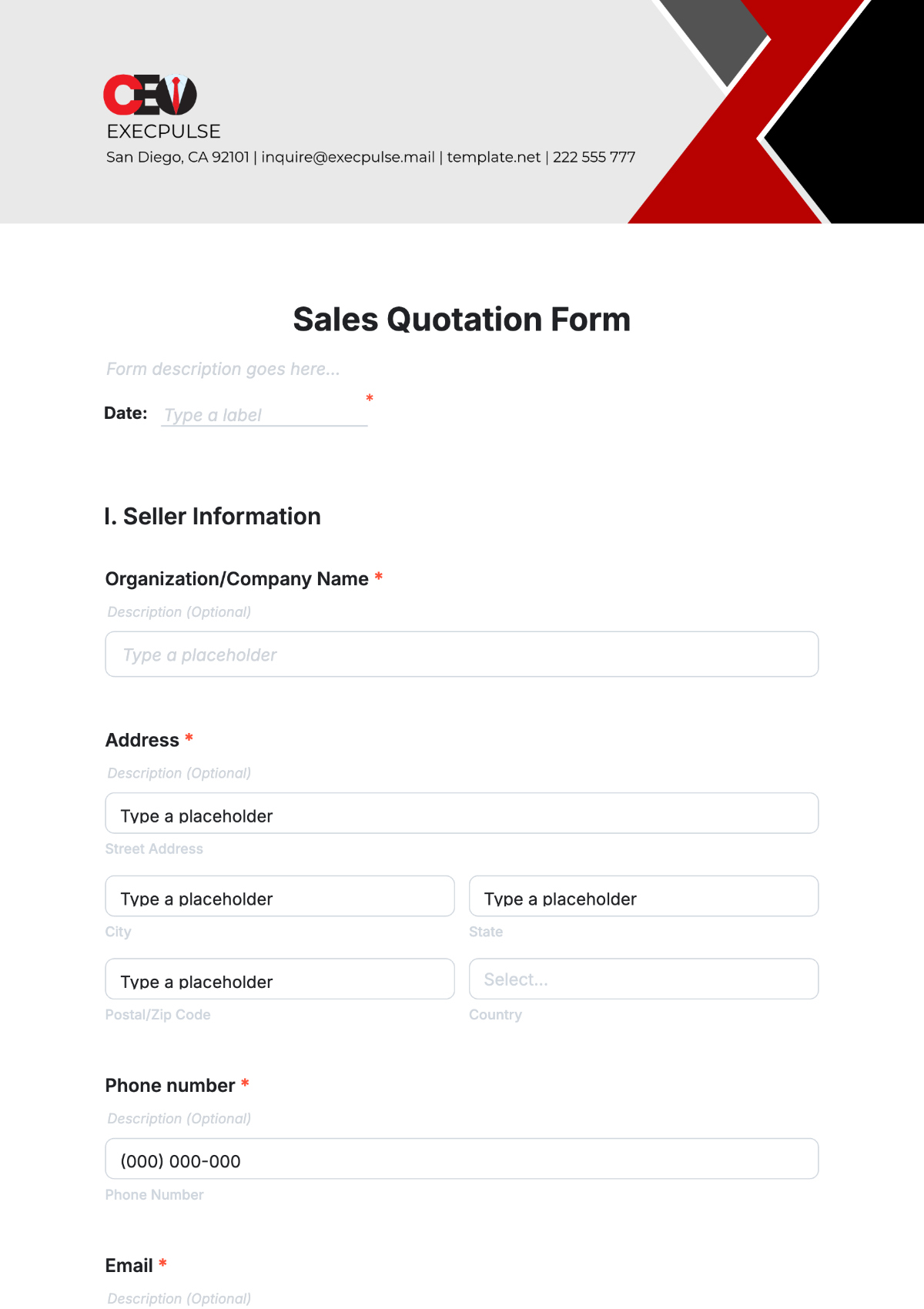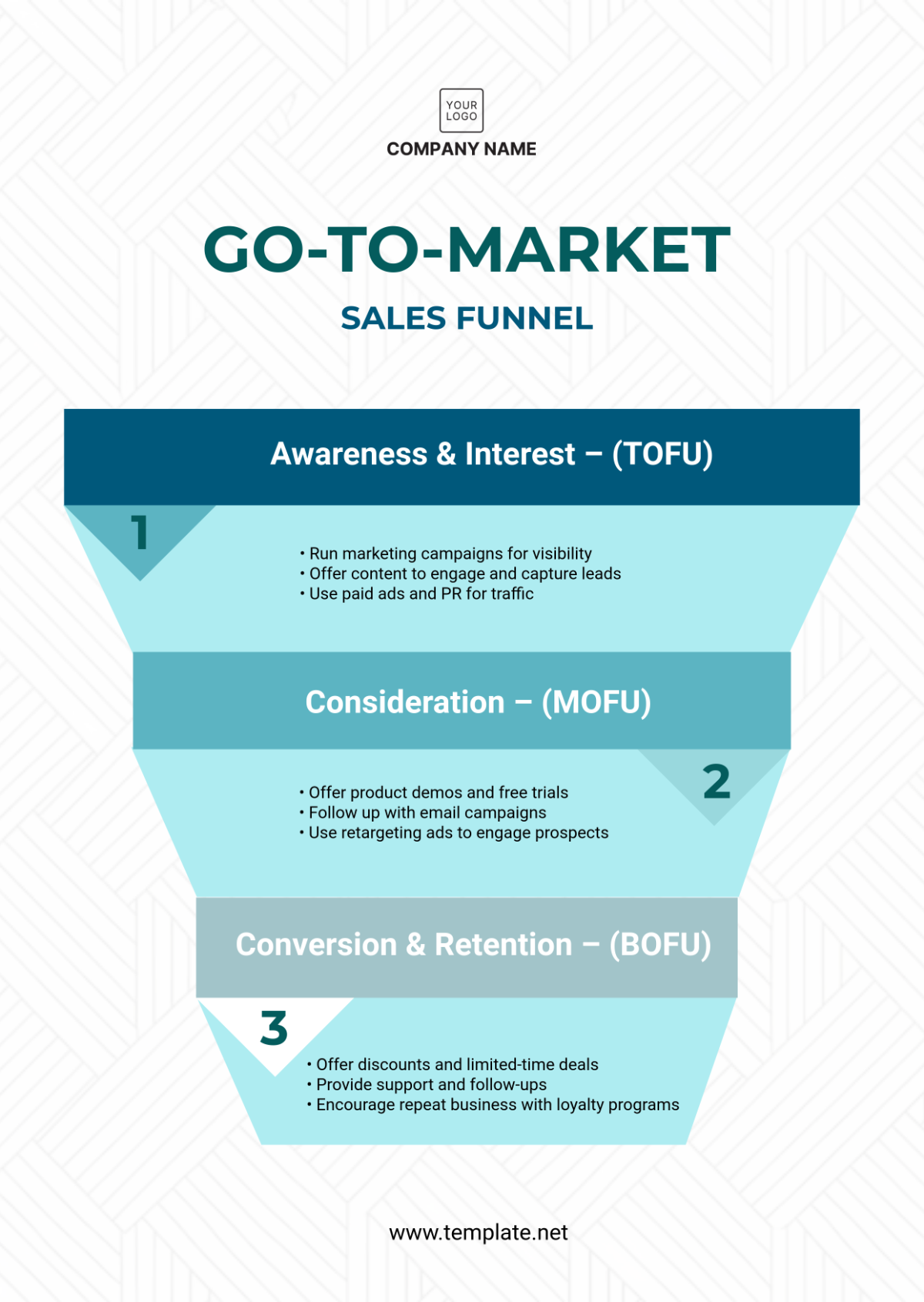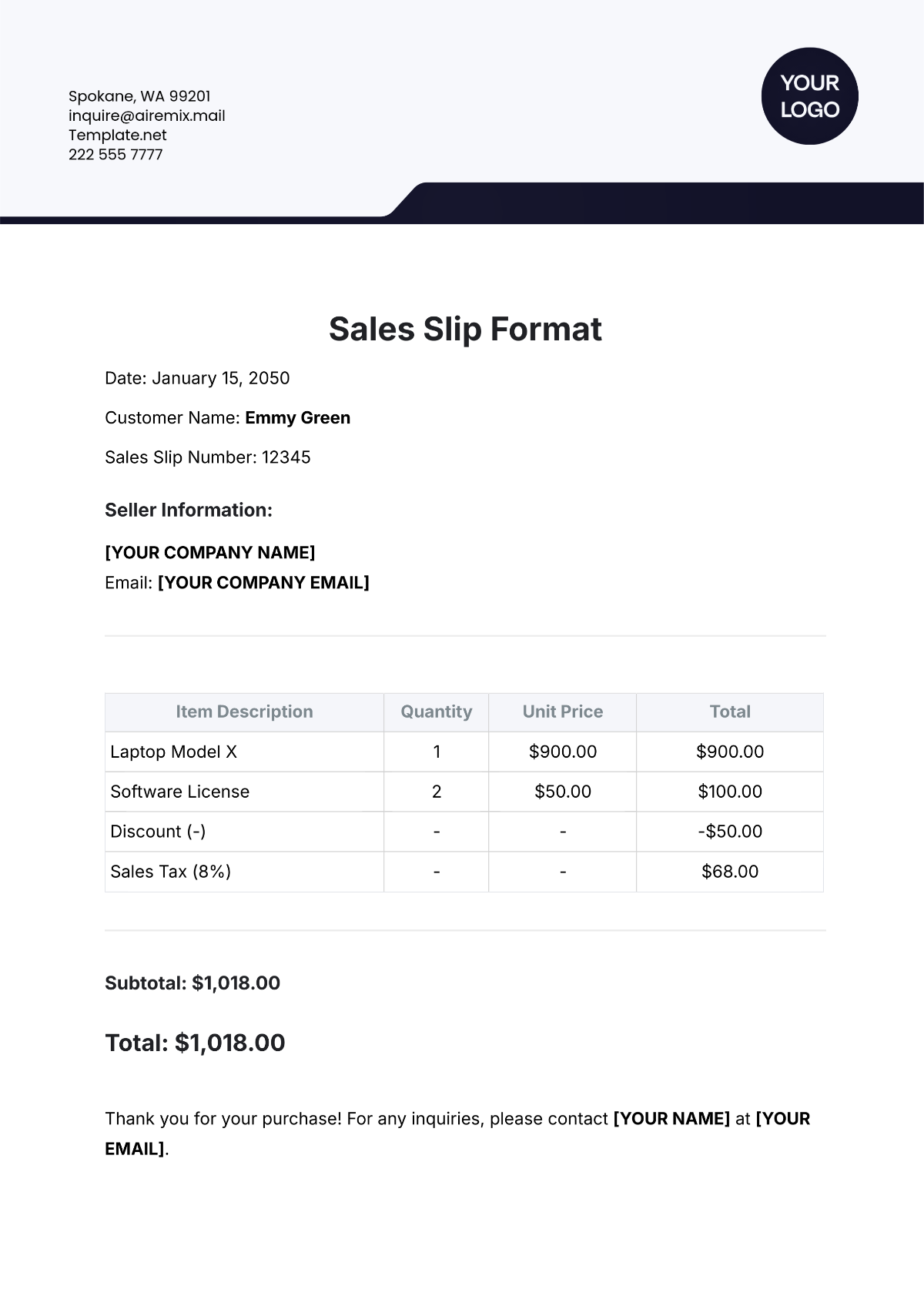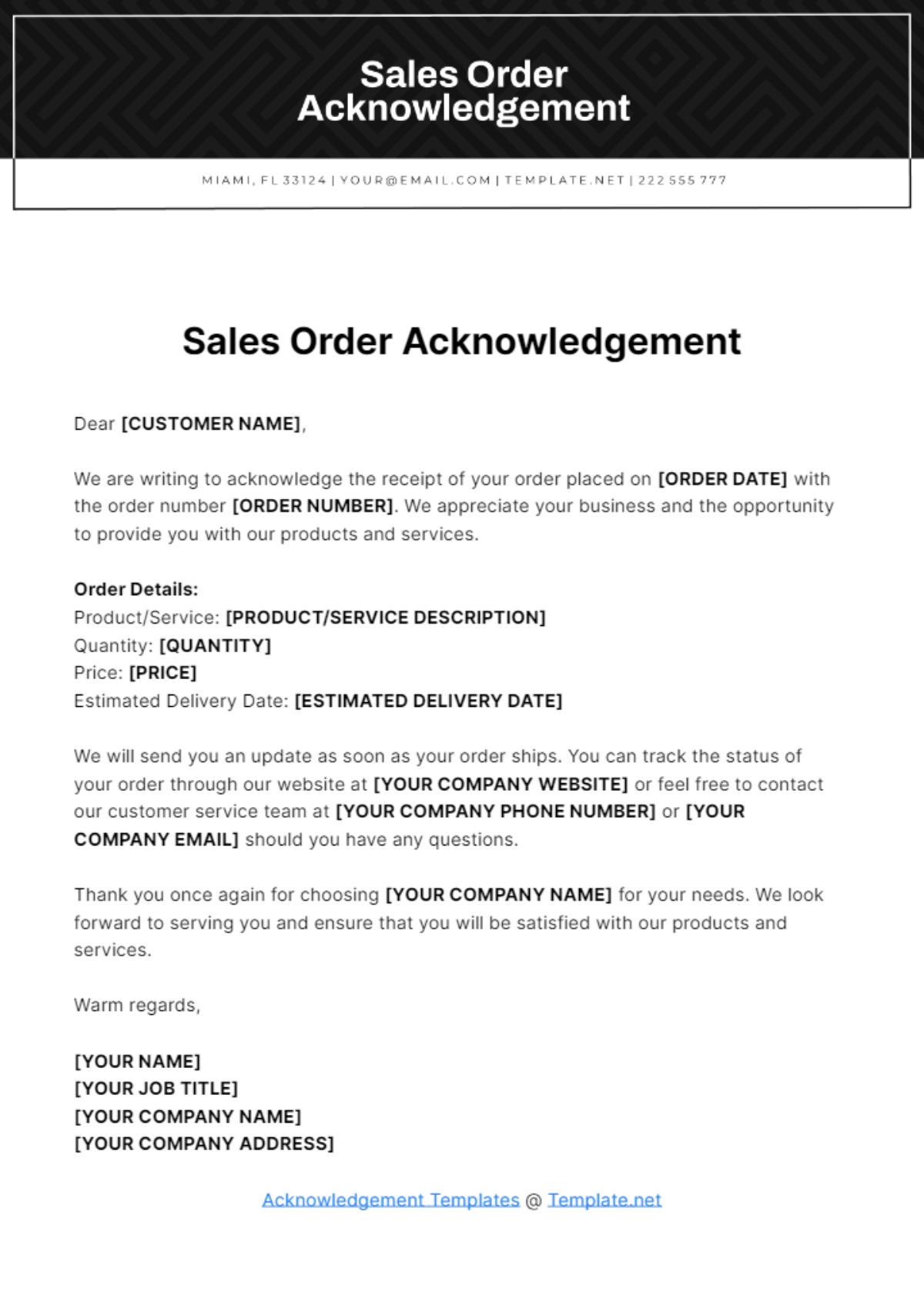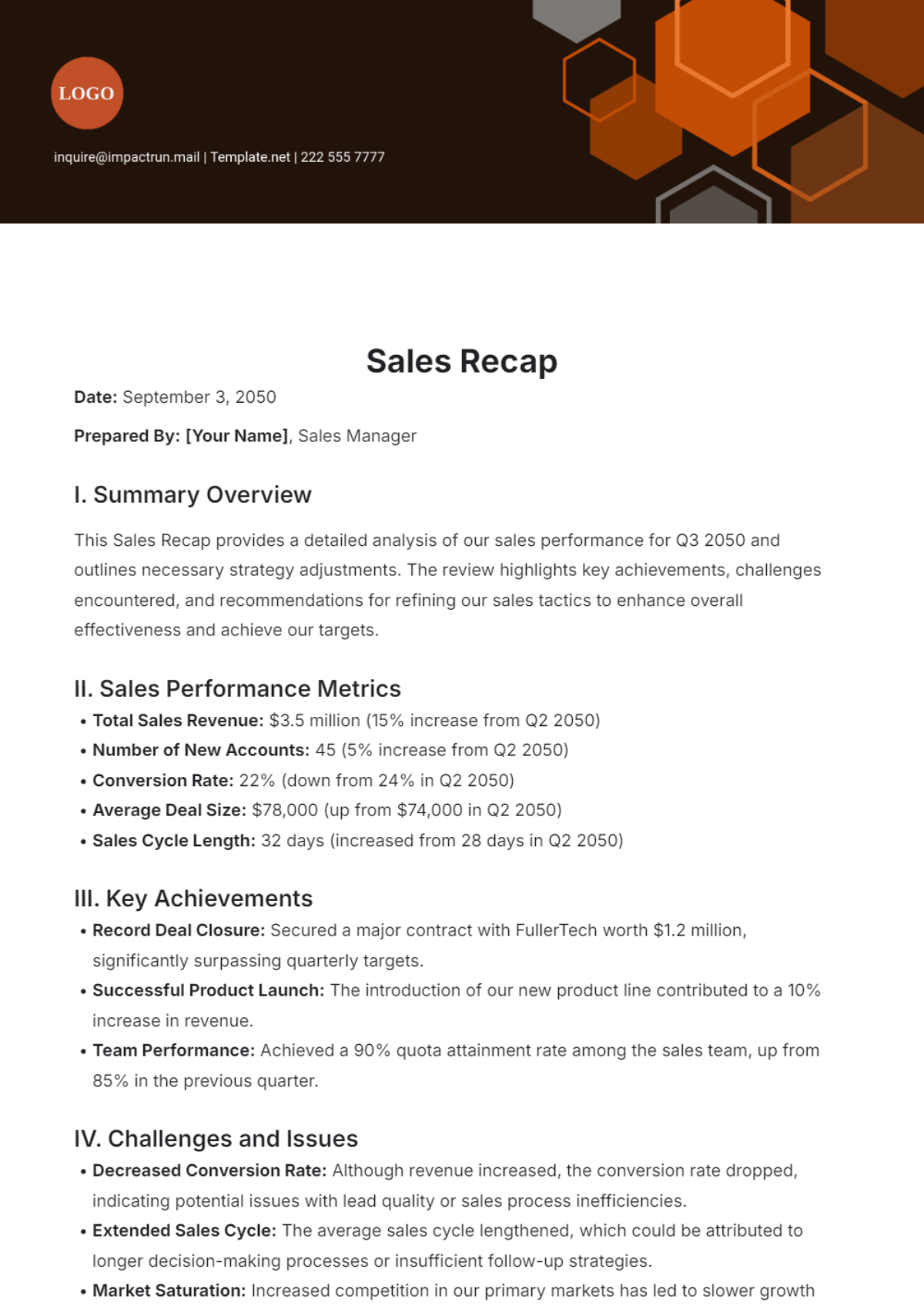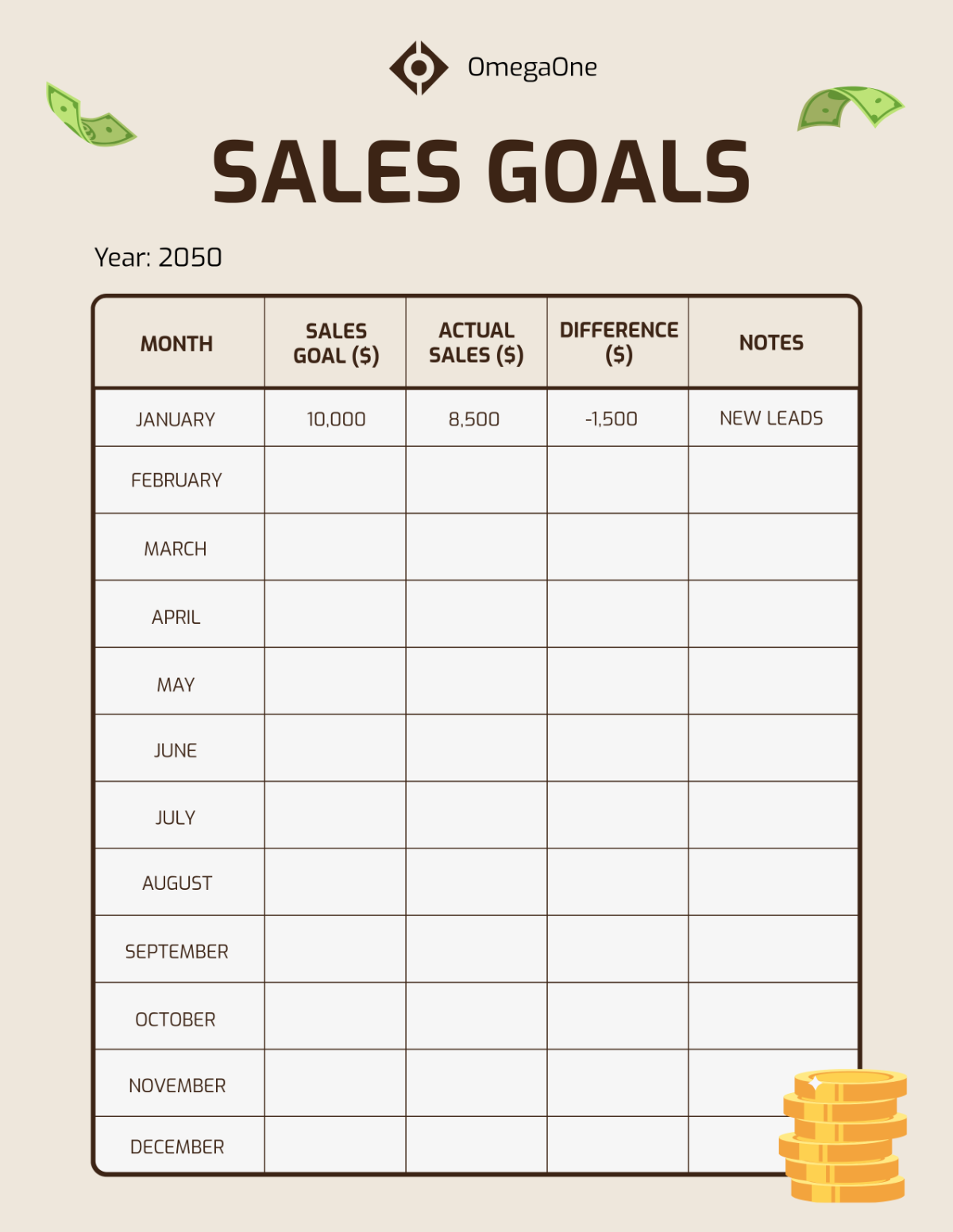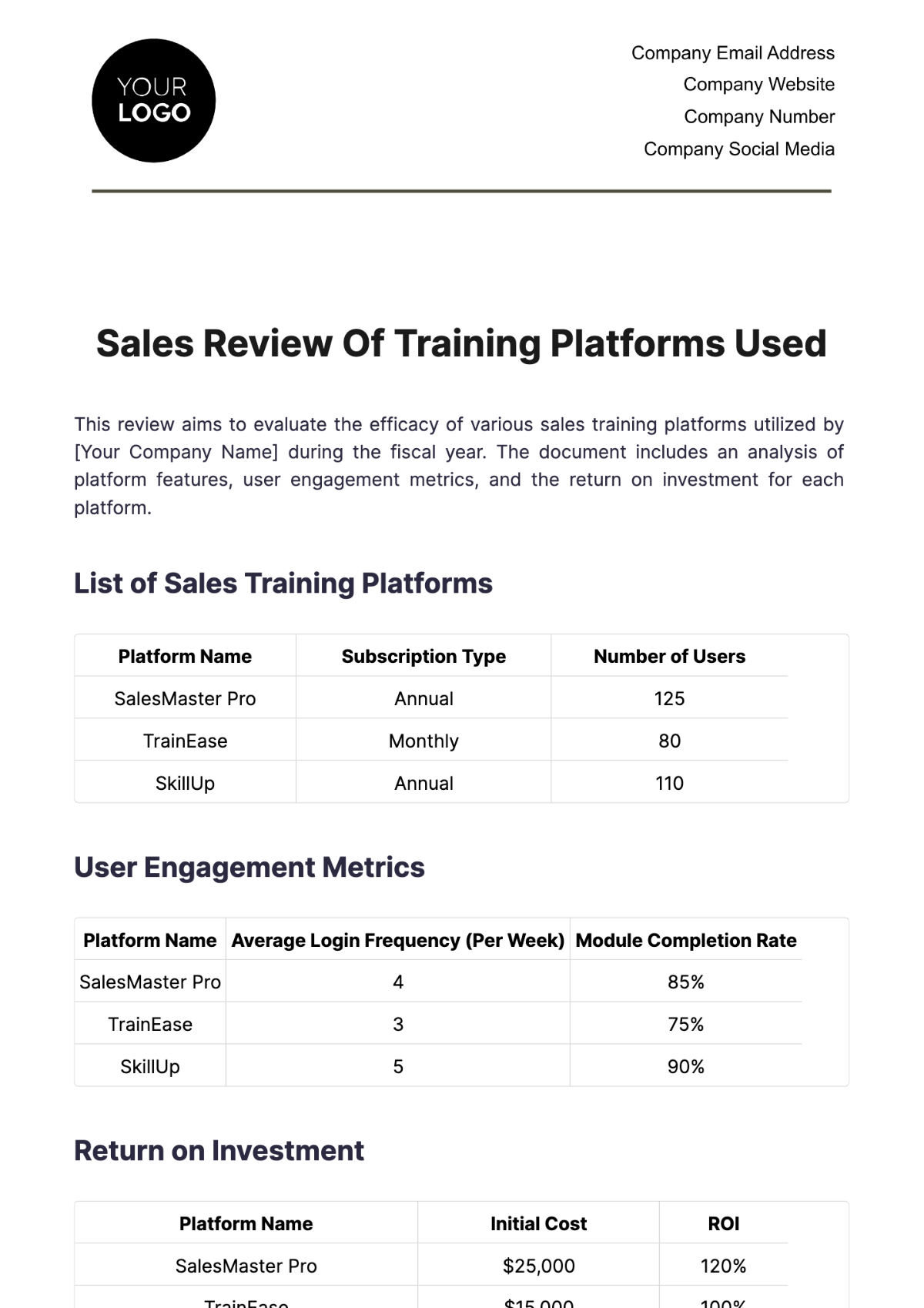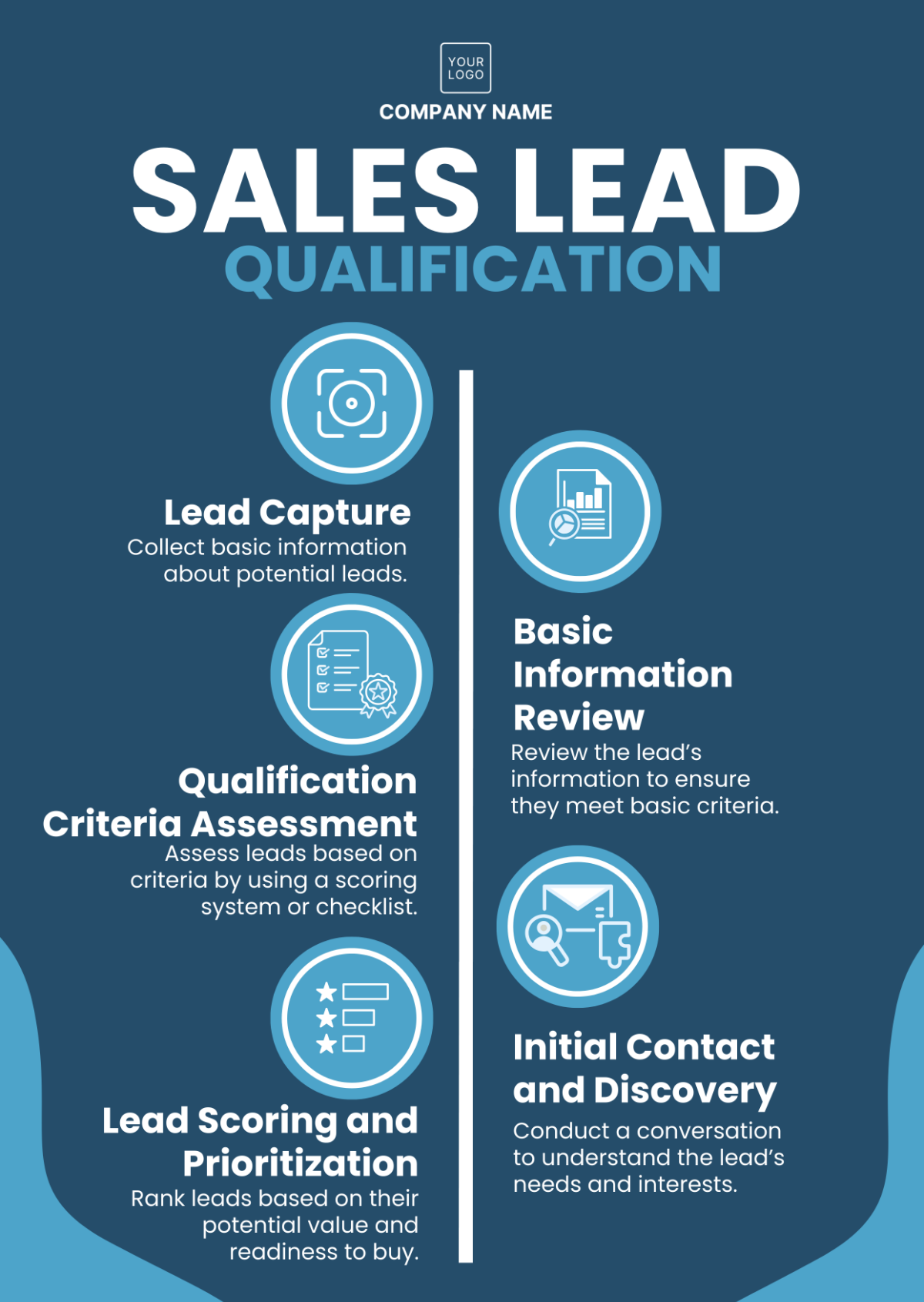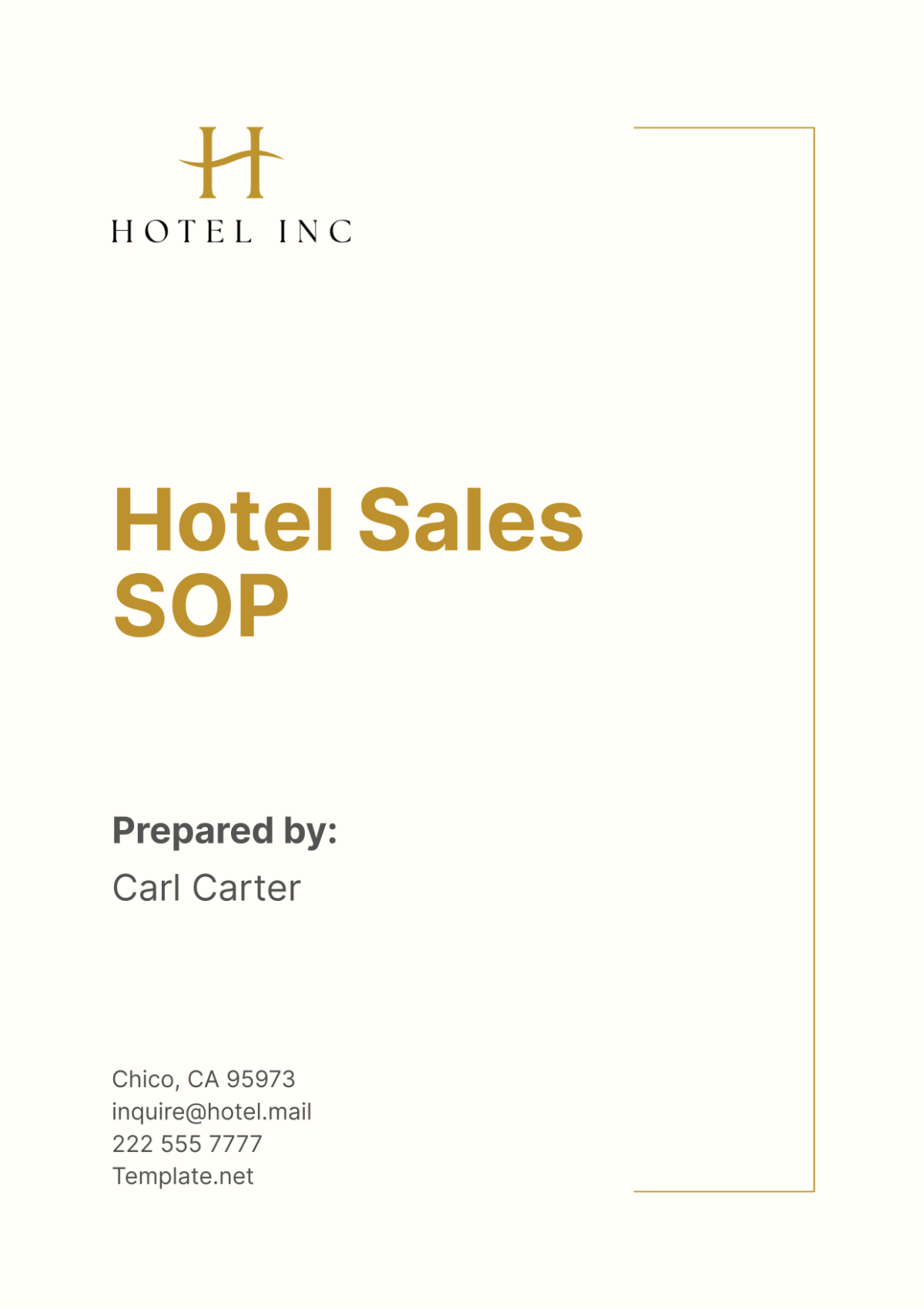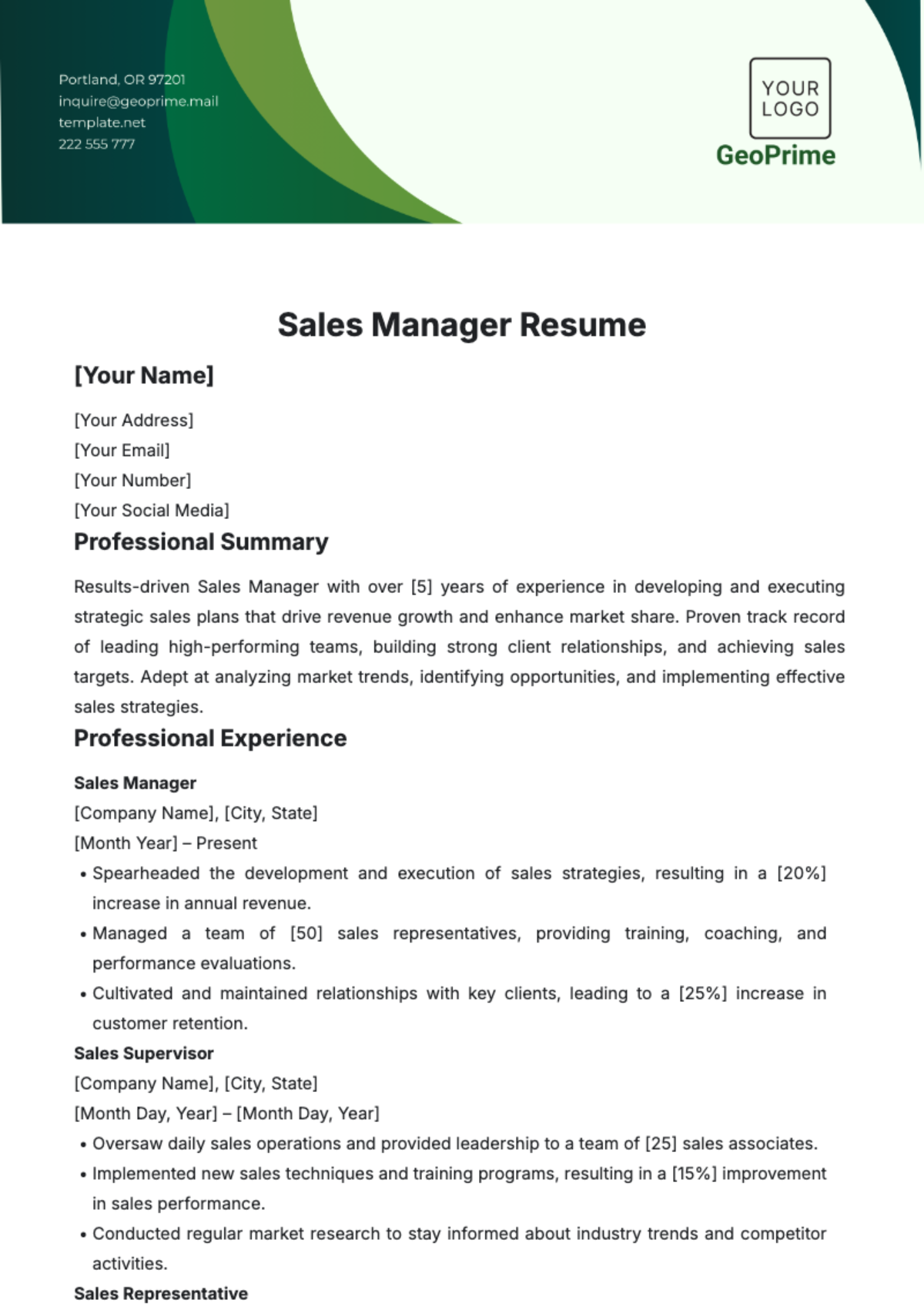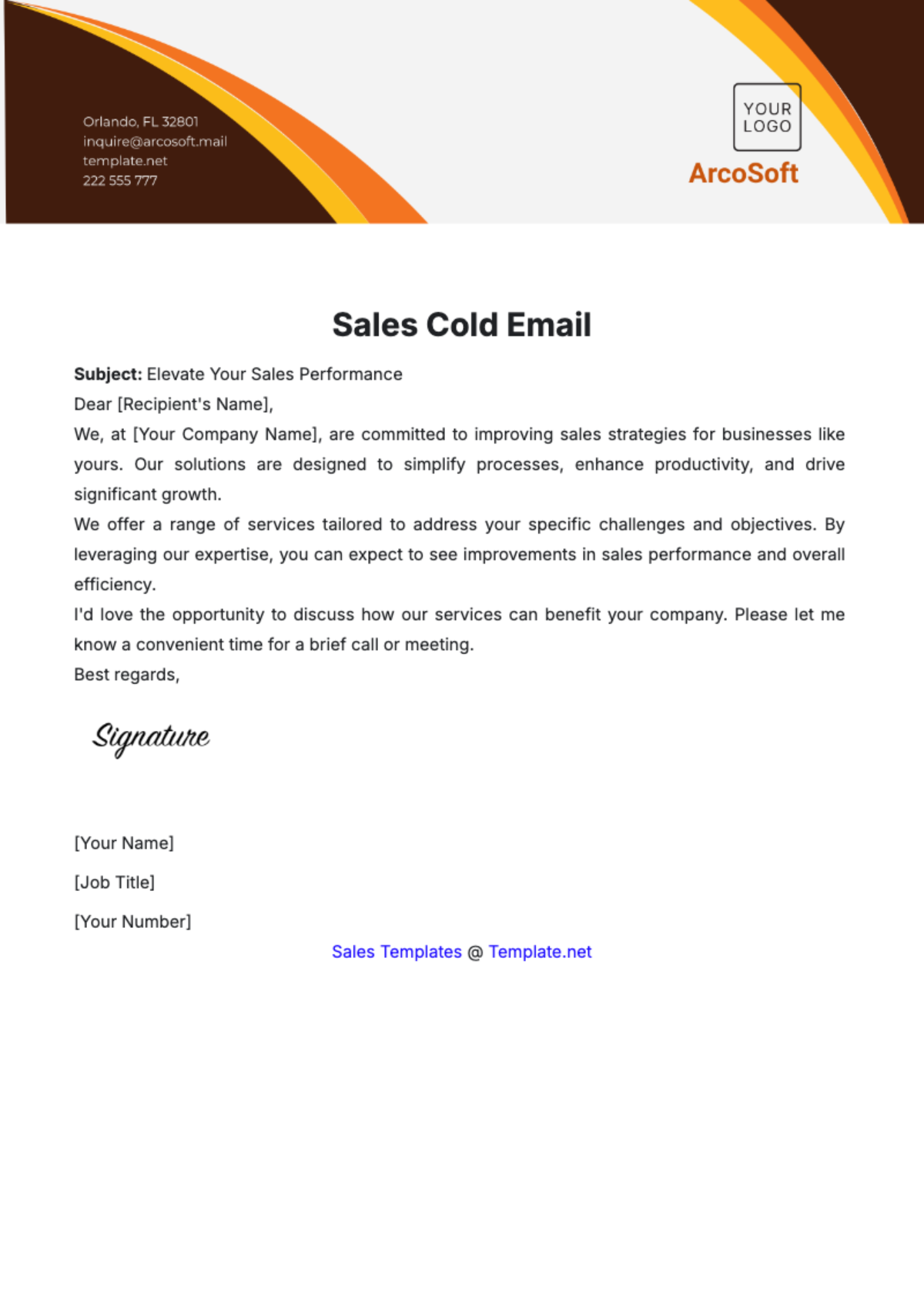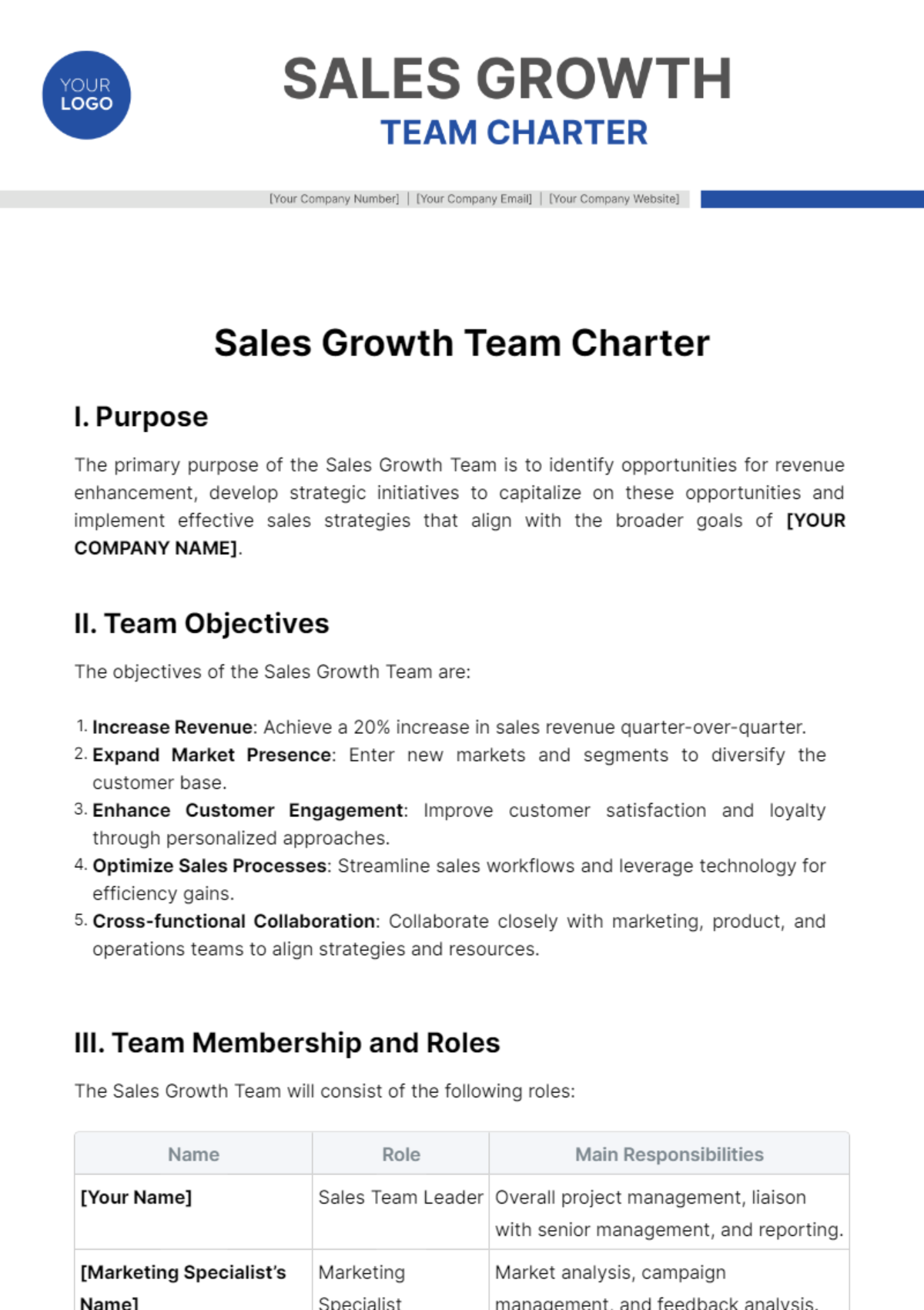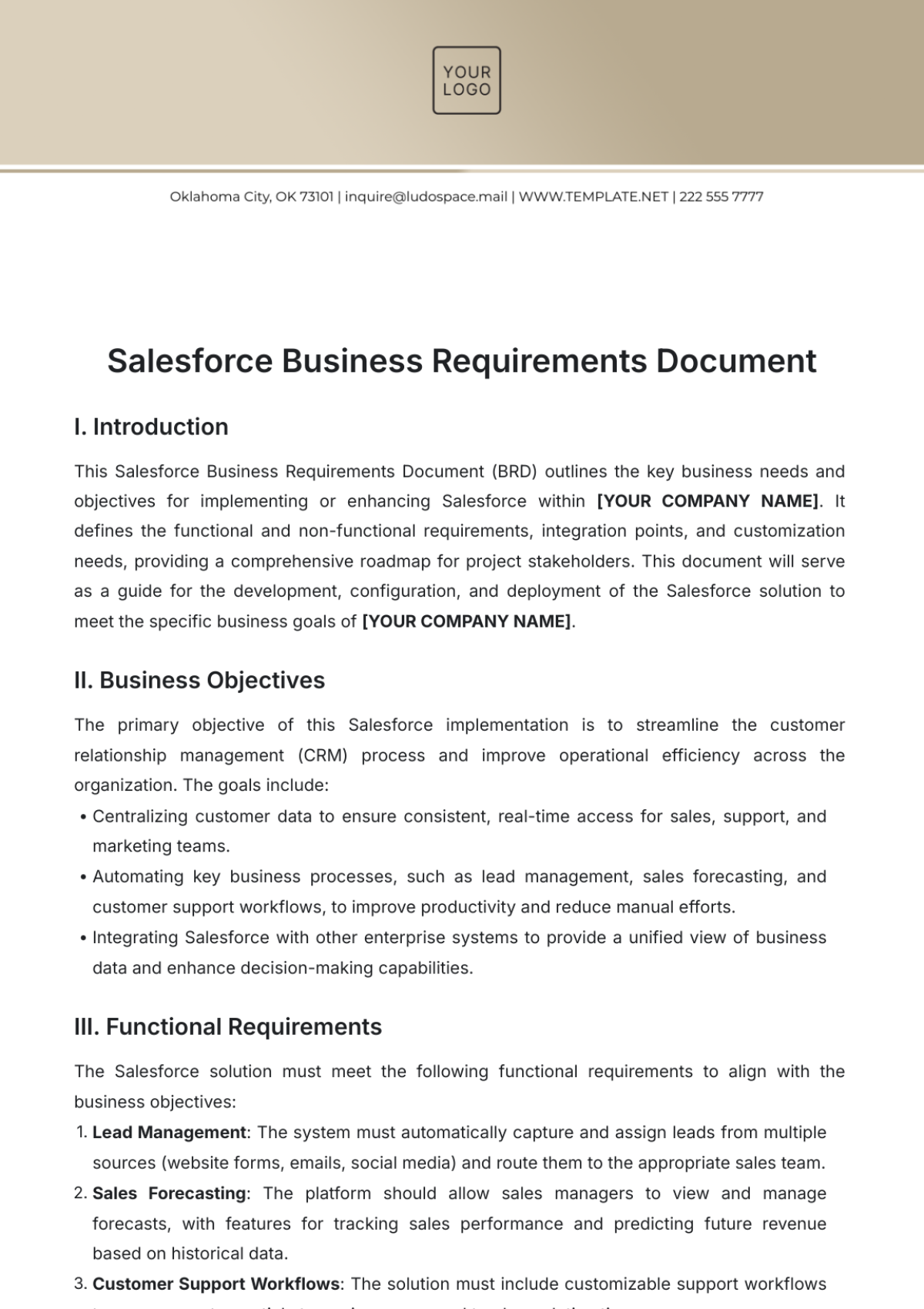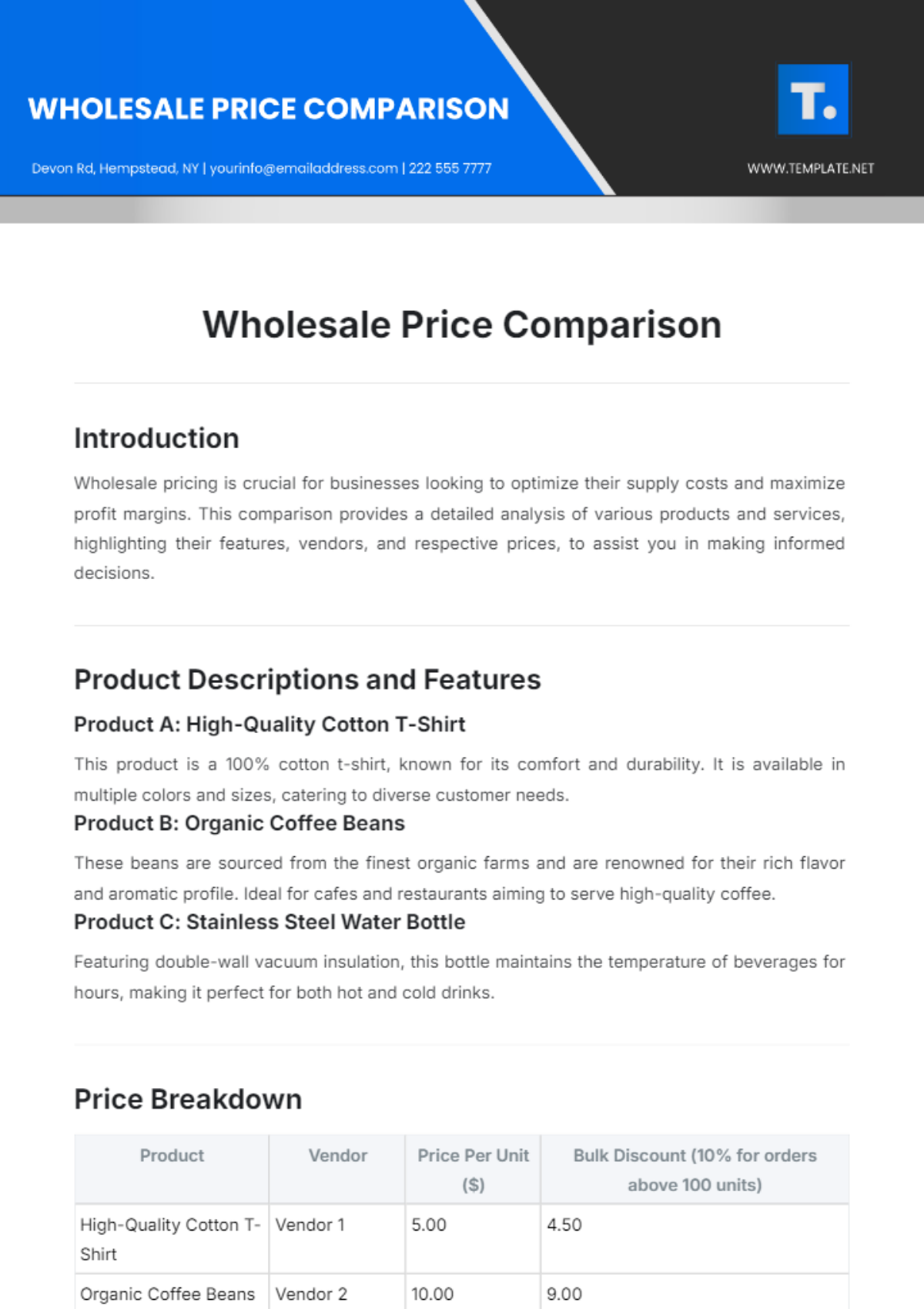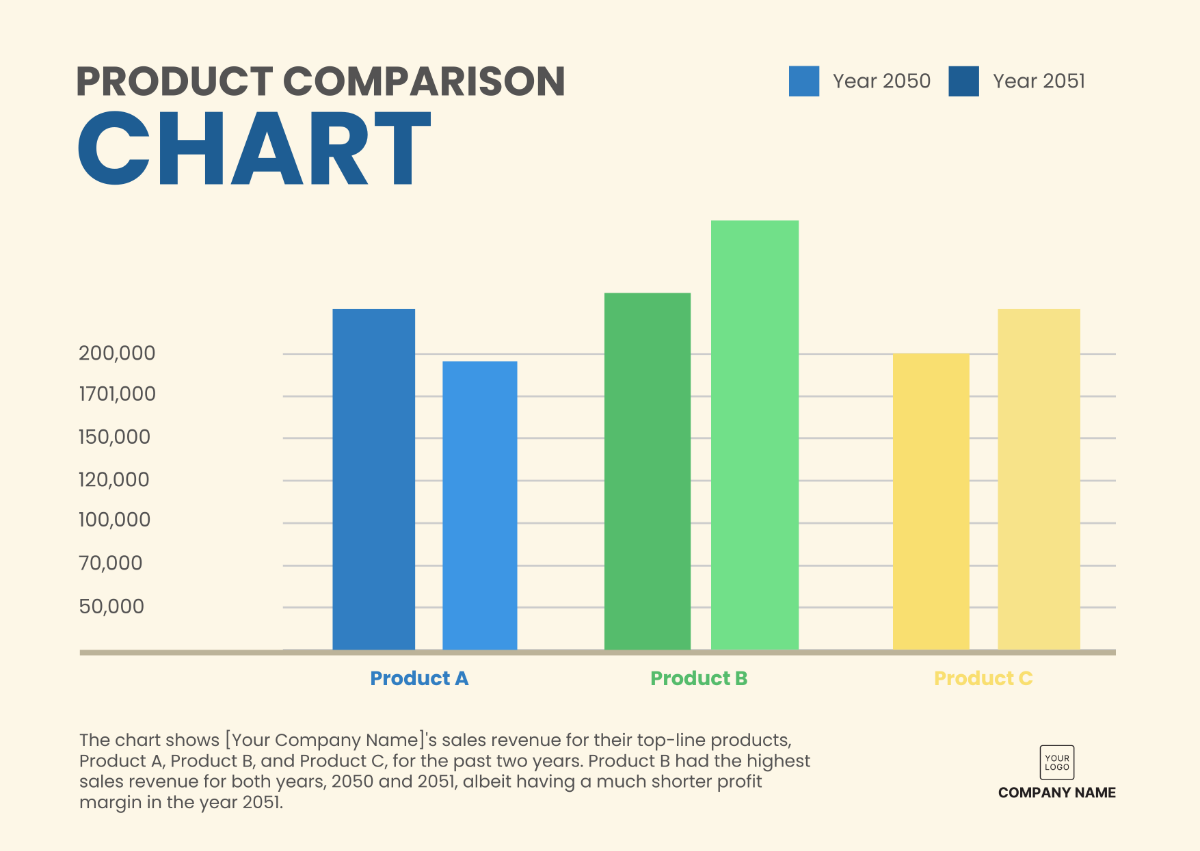Sales Protocol for New Markets
Introduction
As we prepare to expand our operations into new markets, it is crucial to develop a strategic sales protocol that addresses the unique challenges and opportunities these markets present. This document outlines our approach to entering these new territories, from understanding the local market dynamics to tailoring our sales and marketing strategies accordingly. Our goal is to establish a strong presence, meet the specific needs of local customers, and achieve sustainable growth. This sales protocol serves as a roadmap for our teams, ensuring that every step taken is informed, strategic, and aligned with our overarching business objectives.
Market Analysis
Demographics
Our market analysis begins with a comprehensive look at the demographics of our new target markets. Understanding the population's age, income levels, education, and other key demographic factors is vital for tailoring our products and marketing messages. The following table presents a breakdown of these demographics:
Demographic Category | Market A (%) | Market B (%) |
Age Group 18-24 | 20 | 15 |
Age Group 25-34 | 25 | 30 |
Age Group 35-44 | 30 | 25 |
Age Group 45-54 | 15 | 20 |
Age Group 55+ | 10 | 10 |
Median Income | $45,000 | $60,000 |
Higher Education | 40% | 50% |
Competitors
A critical component of our market analysis is understanding the competitive landscape. The following table highlights the key competitors in each new market, along with their market share and primary offerings:
Competitor | Market A Share (%) | Market B Share (%) | Primary Offerings |
Competitor X | 30 | 25 | Product A, Service B |
Competitor Y | 20 | 30 | Service C, Product D |
Competitor Z | 25 | 20 | Product E, Service F |
Customer Behaviors and Market Trends
In Market A, customers prioritize value for money and are highly influenced by social media and online reviews. There's a growing trend towards eco-friendly products and services, reflecting a broader societal shift towards sustainability. In contrast, Market B's consumers are more brand-loyal and seek premium, high-quality products. The use of technology in shopping, especially mobile commerce, is rapidly increasing in both markets.
Regulatory Considerations
Entering these markets requires navigating a complex landscape of regulatory considerations, including:
Consumer Protection Laws
Data Privacy Regulations
Import/Export Taxes
Employment Laws
Product/Service Adaptation
In recognizing the distinct needs and expectations of Markets A and B, it's clear that our existing products and services require thoughtful adaptation to ensure success. For Market A, with its emphasis on value and sustainability, we plan to introduce eco-friendly versions of our products, utilizing biodegradable materials and streamlined packaging to reduce environmental impact. Additionally, pricing strategies will be adjusted to offer competitive value, acknowledging the market's price sensitivity. In Market B, where consumers value brand loyalty and premium quality, we will enhance our product features and offer exclusive, high-end variants. Service delivery in both markets will be optimized for efficiency, with a focus on digital channels in Market B to cater to the tech-savvy consumer base, and a hybrid approach in Market A, balancing online presence with strong local distributor partnerships to build trust and accessibility.
Sales Strategy
Our sales strategy is crafted to align with the unique dynamics of each target market, driven by specific goals, leveraging optimal sales channels, and defined by clear sales processes.
Sales Goals
Establish a market share of at least 10% in both markets within the first two years.
Achieve a customer satisfaction rate exceeding 85% across all new market segments.
Grow the customer base by 25% annually through targeted sales and marketing efforts.
Sales Channels
Channel | Market A | Market B |
Online Direct Sales | ✔ | ✔ |
Local Distributors | ✔ | |
Retail Partnerships | ✔ | ✔ |
Mobile Commerce | ✔ |
Sales Processes
Lead Generation: Implement targeted marketing campaigns in each market to attract potential customers. Utilize social media advertising in Market A and influencer partnerships in Market B to increase brand visibility.
Customer Engagement: Develop personalized engagement strategies, such as localized content for Market A to resonate with the value-oriented customer, and premium, branded experiences for Market B's brand-loyal consumers.
Sales Conversion: Leverage online platforms for direct sales in both markets, with additional support from local distributors in Market A to facilitate trust and overcome logistical challenges. In Market B, focus on a seamless mobile shopping experience to capture the tech-savvy demographic.
Post-Sale Support: Establish a robust customer service framework, utilizing online chat and local customer service centers in Market A to provide accessible, immediate support. In Market B, offer premium support services, including personalized product setup and after-sales care.
Marketing and Promotion Strategy
Our approach to marketing and promotion in Markets A and B is designed to resonate deeply with the local customer base, reflecting their unique customs, preferences, and media consumption habits. In Market A, where value and sustainability are key drivers, our marketing strategy will emphasize the affordability and eco-friendly attributes of our products through digital media campaigns and partnerships with environmentally conscious influencers. For Market B, with a preference for premium products and brand loyalty, we will focus on high-quality, lifestyle-oriented content, leveraging high-end magazines and exclusive events to promote our offerings. Tailored promotions and local engagement are central to our strategy, ensuring relevance and resonance in each market.
Collaborate with local influencers and community leaders to build brand trust and authenticity.
Utilize targeted social media advertising, adapting content to the predominant platforms in each market.
Develop localized content that reflects the cultural values and interests of each market.
Sponsor local events and initiatives to increase brand visibility and community involvement.
Offer introductory promotions to encourage trial and adoption of our products.
Cultural Considerations
Successfully entering new markets requires a nuanced understanding of and respect for local cultures. In Market A, we recognize the importance of community and collective decision-making, planning to engage in community-based marketing efforts and ensuring our messaging emphasizes collective benefits and sustainability. Market B's culture values tradition and quality, guiding us to present our products as enhancements to a refined lifestyle. Communication and partnership strategies will be adapted to reflect these cultural preferences, ensuring that our brand is perceived as respectful and relevant.
Ensure all marketing and sales materials are culturally sensitive and accurately localized, avoiding translation errors or cultural misunderstandings.
Train teams on local customs and etiquette to facilitate respectful and effective interactions with customers and partners.
Adapt customer service practices to meet local expectations for formality, responsiveness, and problem resolution.
Engage with local communities through CSR initiatives that reflect our commitment to being a positive force in the market.
Training and Development
To equip our sales and support teams with the skills and knowledge needed to succeed in Markets A and B, comprehensive training programs will be implemented. These programs are designed to cover product knowledge, cultural sensitivity, and, where necessary, language skills, ensuring that our teams can engage effectively with the local market.
Area of Training | Market A | Market B | Description |
Product Knowledge | ✔ | ✔ | Detailed training on product specifications, benefits, and adaptation to local needs. |
Cultural Sensitivity | ✔ | ✔ | Understanding local customs, communication styles, and business etiquette. |
Language Skills | ✔ | Language training for key team members, focusing on basic communication skills in Market A. | |
Local Market Dynamics | ✔ | ✔ | Insights into consumer behavior, market trends, and competitive landscape. |
Digital Tools & Platforms | ✔ | ✔ | Training on leveraging digital sales and marketing tools preferred in the local markets. |
Risk Management
Entering new markets involves inherent risks that must be carefully managed to ensure the success of our expansion strategy. We have identified several key risks associated with Markets A and B, evaluating their likelihood, potential impact on our operations, and outlining strategies for mitigation. This proactive approach enables us to anticipate challenges and implement solutions in advance, safeguarding our investments and growth ambitions.
Risk | Likelihood | Impact | Mitigation Strategy |
Cultural Misunderstandings | Medium | High | Cultural sensitivity training and local market consultants. |
Regulatory Compliance Issues | High | High | Engage legal experts to navigate local regulations. |
Supply Chain Disruptions | Low | Medium | Diversify suppliers and establish local partnerships. |
Market Entry Resistance | Medium | Medium | Tailored marketing strategies and community engagement. |
Competitive Retaliation | High | High | Continuous innovation and value proposition enhancement. |
Performance Monitoring and Evaluation
To measure our success in Markets A and B, we have established specific performance indicators, set target metrics, and defined the methods for evaluation. This structured approach allows us to track progress, identify areas for improvement, and make informed decisions to adjust our strategies as necessary.
Performance Indicator | Target Metric | Evaluation Method |
Market Share Growth | 10% annually | Market analysis and sales data review. |
Customer Satisfaction Level | 85% or higher | Surveys and customer feedback collection. |
Sales Volume Increase | 25% increase annually | Sales reports and market trends analysis. |
Brand Awareness in New Market | 50% recognition within first year | Surveys and digital analytics. |
Customer Retention Rate | 75% retention | Customer relationship management system tracking. |
Conclusion
Our Sales Protocol for New Markets outlines a comprehensive strategy designed to navigate the complexities of entering and establishing a strong presence in Markets A and B. Through careful market analysis, product adaptation, and strategic sales and marketing efforts, we are poised to meet the unique needs and preferences of these new customer bases. Our commitment to cultural sensitivity, coupled with robust training and risk management practices, positions us to overcome potential challenges and capitalize on the opportunities ahead. By closely monitoring our performance and remaining adaptable to market dynamics, we are confident in our ability to achieve sustainable growth and success in these new territories. This protocol not only serves as our roadmap to expansion but also reflects our broader commitment to innovation, customer satisfaction, and global reach.




